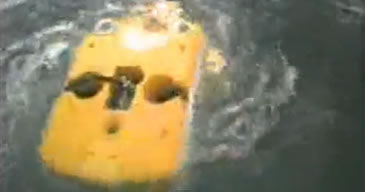Lynx
work-class rov
The Seaeye Lynx is a development of the successful Seaeye Puma but in a larger frame to provide improved water flow through the vectored and vertical thrusters. So successful has been this modification that the performance of the Seaeye Lynx matches that of the smaller and lighter Seaeye Tiger observation ROV.
Seaeye Lynx is a 1500msw rated fully integrated inspection tool with a powerful performance envelope and a high payload for a vehicle of this size. The vehicle is powered by 6 off Seaeye brushless DC thruster units, which are proven worldwide. The system is designed to operate free swimming or in conjunction with a Seaeye Type 8 Tether Management System (TMS), which provides a 200 metre excursion radius. The system has various useful options such as a 440vac 3-phase outlet for powering water jetting equipment and the capacity to fit standard or custom work-skid packages fixed to the underside of the vehicle.
Chassis
100% modular chassis manufactured in polypropylene. This extremely rugged material is totally maintenance free, non-corroding and self-supporting in seawater. Additional equipment may be bolted directly onto the chassis members. The Seaeye Lynx Chassis is designed to accommodate a range of standard or custom under slung tooling Skids
Propulsion
All Seaeye ROVs feature brushless DC thrusters, which, apart from having the greatest power density, have integrated drive electronics with velocity feedback for precise and rapid thrust control. These thrusters are interfaced to a fast PID control system along with a solid-state rate gyro for enhanced azimuth stability. These essential building blocks enable Saab Seaeye to provide superior control and response from their powerful ROVs, setting them apart from the competition.
Six Seaeye SM4M brushless DC thrusters propel Seaeye Lynx. The Thruster configuration is four vectored horizontal units and two vertical units providing full three-dimensional control.
Video System
The standard video system allows for four video channels being multiplexed onto two fibres to the surface junction box, where they are converted back to electrical signals on coaxial cables to the system monitors.
If the fourth channel is not required then this may be used for the digital stills camera control, if fitted. A zoom and focus control facility is also fitted as standard.
Lighting
Two individually controlled lighting channels. Each channel has its own brilliance control on the pilots HCU. A total of 600 watts of lighting is fitted as standard. Each lamp unit is individually fused to facilitate easier maintenance in the event of a lamp bulb failure.
Buoyancy
Syntactic foam in a single moulded shape with apertures provided for sonar, Xenon strobe and tracking transponders.





